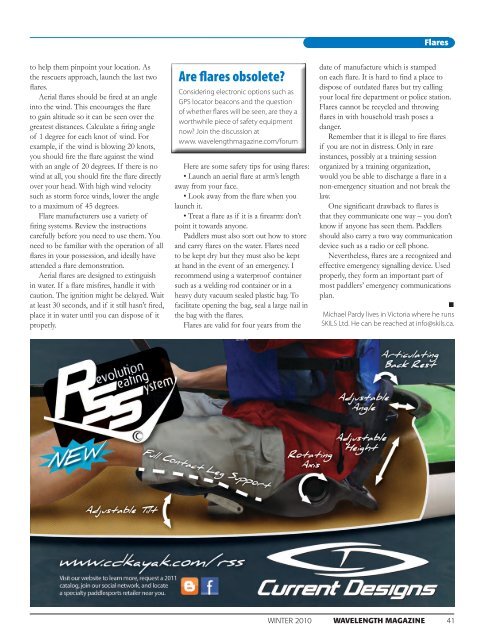Tricked out kayaks Hitting the water - Wavelength Paddling Magazine
Tricked out kayaks Hitting the water - Wavelength Paddling Magazine
Tricked out kayaks Hitting the water - Wavelength Paddling Magazine
You also want an ePaper? Increase the reach of your titles
YUMPU automatically turns print PDFs into web optimized ePapers that Google loves.
Flares<br />
to help <strong>the</strong>m pinpoint your location. As<br />
<strong>the</strong> rescuers approach, launch <strong>the</strong> last two<br />
flares.<br />
Aerial flares should be fired at an angle<br />
into <strong>the</strong> wind. This encourages <strong>the</strong> flare<br />
to gain altitude so it can be seen over <strong>the</strong><br />
greatest distances. Calculate a firing angle<br />
of 1 degree for each knot of wind. For<br />
example, if <strong>the</strong> wind is blowing 20 knots,<br />
you should fire <strong>the</strong> flare against <strong>the</strong> wind<br />
with an angle of 20 degrees. If <strong>the</strong>re is no<br />
wind at all, you should fire <strong>the</strong> flare directly<br />
over your head. With high wind velocity<br />
such as storm force winds, lower <strong>the</strong> angle<br />
to a maximum of 45 degrees.<br />
Flare manufacturers use a variety of<br />
firing systems. Review <strong>the</strong> instructions<br />
carefully before you need to use <strong>the</strong>m. You<br />
need to be familiar with <strong>the</strong> operation of all<br />
flares in your possession, and ideally have<br />
attended a flare demonstration.<br />
Aerial flares are designed to extinguish<br />
in <strong>water</strong>. If a flare misfires, handle it with<br />
caution. The ignition might be delayed. Wait<br />
at least 30 seconds, and if it still hasn’t fired,<br />
place it in <strong>water</strong> until you can dispose of it<br />
properly.<br />
Are flares obsolete?<br />
Considering electronic options such as<br />
GPS locator beacons and <strong>the</strong> question<br />
of whe<strong>the</strong>r flares will be seen, are <strong>the</strong>y a<br />
worthwhile piece of safety equipment<br />
now? Join <strong>the</strong> discussion at<br />
www. wavelengthmagazine.com/forum<br />
Here are some safety tips for using flares:<br />
• Launch an aerial flare at arm’s length<br />
away from your face.<br />
• Look away from <strong>the</strong> flare when you<br />
launch it.<br />
• Treat a flare as if it is a firearm: don’t<br />
point it towards anyone.<br />
Paddlers must also sort <strong>out</strong> how to store<br />
and carry flares on <strong>the</strong> <strong>water</strong>. Flares need<br />
to be kept dry but <strong>the</strong>y must also be kept<br />
at hand in <strong>the</strong> event of an emergency. I<br />
recommend using a <strong>water</strong>proof container<br />
such as a welding rod container or in a<br />
heavy duty vacuum sealed plastic bag. To<br />
facilitate opening <strong>the</strong> bag, seal a large nail in<br />
<strong>the</strong> bag with <strong>the</strong> flares.<br />
Flares are valid for four years from <strong>the</strong><br />
date of manufacture which is stamped<br />
on each flare. It is hard to find a place to<br />
dispose of <strong>out</strong>dated flares but try calling<br />
your local fire department or police station.<br />
Flares cannot be recycled and throwing<br />
flares in with household trash poses a<br />
danger.<br />
Remember that it is illegal to fire flares<br />
if you are not in distress. Only in rare<br />
instances, possibly at a training session<br />
organized by a training organization,<br />
would you be able to discharge a flare in a<br />
non-emergency situation and not break <strong>the</strong><br />
law.<br />
One significant drawback to flares is<br />
that <strong>the</strong>y communicate one way – you don’t<br />
know if anyone has seen <strong>the</strong>m. Paddlers<br />
should also carry a two way communication<br />
device such as a radio or cell phone.<br />
Never<strong>the</strong>less, flares are a recognized and<br />
effective emergency signalling device. Used<br />
properly, <strong>the</strong>y form an important part of<br />
most paddlers’ emergency communications<br />
plan.<br />
•<br />
Michael Pardy lives in Victoria where he runs<br />
SKILS Ltd. He can be reached at info@skils.ca.<br />
WINTER 2010 WAVELENGTH MAGAZINE 41

















